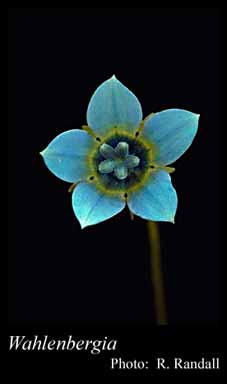- Reference
- Nov.Pl.Sp. p399 (1821)
- Name Status
- Current

Scientific Description
Family Campanulaceae.
Habit and leaf form. Herbs, or shrubs (non-Australian species only); laticiferous. Herbs annual, or perennial; plants with a basal concentration of leaves, or with neither basal nor terminal concentrations of leaves. Helophytic to xerophytic. Leaves alternate, or alternate and opposite (then either opposite on the lower stem becoming alternate above, or irregularly opposite and alternate); petiolate to sessile; not gland-dotted; simple; epulvinate. Leaf blades entire. Leaves without stipules. Leaf blade margins entire, or serrate, or dentate. Leaves without a persistent basal meristem. Leaf anatomy. Hydathodes very commonly present. Hairs present, or absent. Stem anatomy. Nodes unilacunar. Secondary thickening developing from a conventional cambial ring.
Reproductive type, pollination. Fertile flowers hermaphrodite. Unisexual flowers absent. Plants hermaphrodite. Entomophilous. Pollination mechanism conspicuously specialized (the pollen is shed onto the hairy upper part of the style before the flower opens, and falls away before the stigmatic lobes recurve and become receptive and the stigmatic hairs lengthen).
Inflorescence and flower features. Flowers solitary, or aggregated in ‘inflorescences’; in cymes, or in panicles (thrysoids of varying complexity). The terminal inflorescence unit cymose, or racemose. Inflorescences scapiflorous, or not scapiflorous; terminal. Flowers bi- bracteolate; small to medium-sized; regular; 5 merous; cyclic; tetracyclic. Perianth with distinct calyx and corolla; 10; 2 -whorled; isomerous. Calyx 5; 1 -whorled; polysepalous, or gamosepalous (depending on interpretation — the ‘tube’ nearly always being united with the ovary); hairy, or glabrous; imbricate, or valvate; persistent. Corolla 5; 1 -whorled; gamopetalous; valvate; often campanulate, or rotate; regular; glabrous abaxially; hairy adaxially (usually puberulous at base of tube), or glabrous adaxially; blue (usually, darker in colour on inner surface of lobes). Androecium 5. Androecial members free of the perianth; free of one another; 1 -whorled. Androecium exclusively of fertile stamens. Stamens 5; isomerous with the perianth; oppositisepalous; all alternating with the corolla members. Anthers basifixed; dehiscing via longitudinal slits; introrse; tetrasporangiate. Gynoecium 2 carpelled, or 3 carpelled, or 5 carpelled. The pistil 2 celled, or 3 celled, or 5 celled. Gynoecium syncarpous; synstylovarious; inferior. Ovary plurilocular; 2 locular, or 3 locular, or 5 locular. Styles 1; 2- or 3- or 5-fid, and distinctly protandrous. Stigmas 2, or 3, or 5 (as many as the carpels); wet type, or dry type; papillate, or non-papillate; Group II type and Group IV type. Placentation axile. Ovules 10–50 per locule (i.e. ‘many’); horizontal; non-arillate; anatropous.
Fruit and seed features. Fruit non-fleshy; hairy, or not hairy; dehiscent; a capsule. Capsules opening by apical slits. Fruit 10–50 seeded (i.e. ‘many’). Seeds endospermic. Endosperm oily. Seeds small. Cotyledons 2. Embryo straight. Testa smooth. Seedling. Germination phanerocotylar.
Geography, cytology, number of species. Native of Australia. Not endemic to Australia. Australian states and territories: Western Australia, South Australia, Northern Territory, Queensland, New South Wales, Victoria, Australian Capital Territory, and Tasmania. Northern Botanical Province, Eremaean Botanical Province, and South-West Botanical Province.